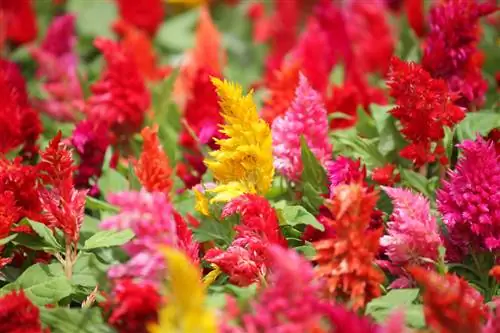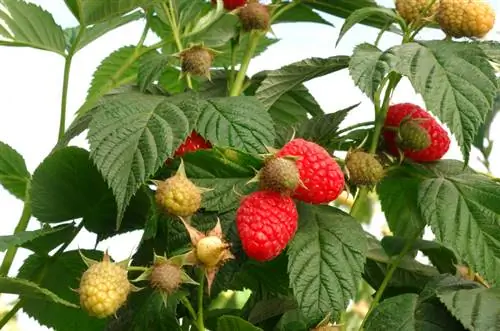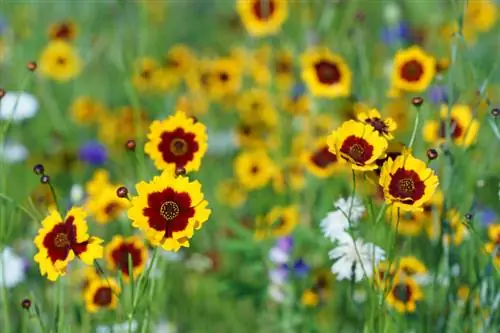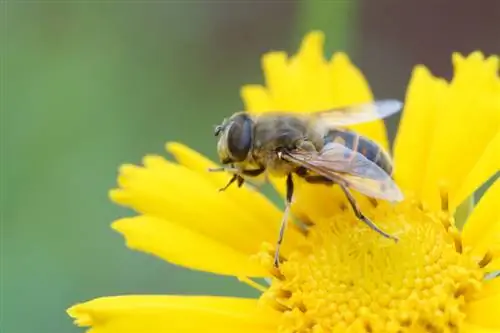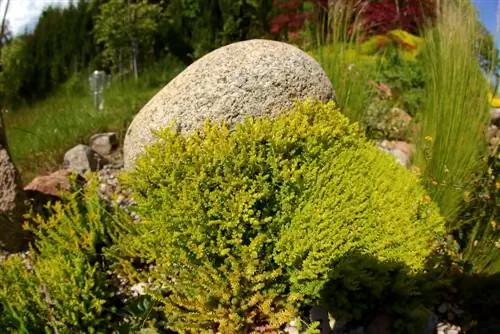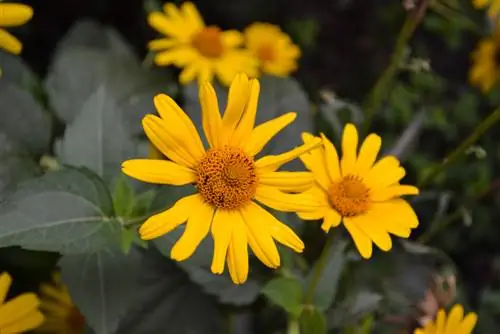- Author admin [email protected].
- Public 2023-12-25 17:45.
- Last modified 2025-01-23 11:20.
The magical celosia draws from a pool of varied inflorescences. The floral spectrum extends from colorful fluffy flowers to feathery lightweights and striking cockscombs. How good that there is agreement among the multi-faceted Brandschopf varieties, at least when it comes to cultivation. Read precise answers to frequently asked questions here.

How do I properly care for a Celosia plant?
Celosia plants need a sunny, warm location, moderate watering with lime-free water, regular fertilization and the removal of wilted flowers. They can be cultivated in beds or pots and kept for several years with proper care.
Care tips
Don't be confused by the different inflorescences. Regardless of whether the squall presents itself with feathers, tufts or cockscombs - the care program is the same for all varieties. How to do it right:
- If the substrate is dry, water moderately with lime-free water
- From May/June to September, fertilize the bed organically every 4 weeks
- Fertilize Brandschopf liquidly in the pot every 2-3 weeks
- Cut off wilted flowers and yellowed leaves
Celosia in a planter has good prospects of being cultivated for several years. Put the flower away in the fall to keep it warm and light or cool and dark through the cold season. Water at a reduced rate depending on the light and temperature conditions.read more
Which location is suitable?
Reserve a sunny, warm and protected location for your fireclaw that cannot come under the blazing midday sun. Ideally, this place is under an eaves, an awning under the protection of tall deciduous trees so that pattering rain does not affect the pom-pom flowers. Your Celosia will be completely happy if it can stretch out its roots in fresh, humus-rich and slightly acidic soil.
When is flowering time?
The different flower shapes as clusters, feathers or combs result from a genetic change within the Celosia genus. This whim of Mother Nature gives us a wide range of magnificent Brandschopf varieties, which nevertheless delight us with their splendor of flowers over a uniform period from June to October. If you clean out withered flower heads promptly, the next buds will develop within a few days.
Cut celosia correctly
Simply cut off the withered flowers on your bush. In this way the neat appearance is maintained. At the same time, the next buds can start their colorful appearance unhindered. The same applies to yellowed or curled leaves. Thanks to their lush branching, celosias can easily do without a few flower stems so that they can decorate the home as vase decorations. On top of that, the exotic plant provides dimensionally stable material for a long-lasting dry bouquet. To do this, cut off the shoots immediately before full bloom and dry them upside down in an airy place.
Watering Celosia
Pour a choux moderately. In concrete terms, this requirement means that you only use the watering can when the soil is completely dry. Allow the water to run slowly onto the root ball to stop in time when it stops absorbing moisture. Pamper your Celosia with soft water like she knows from her tropical home. Hard tap water contains too much lime and causes the pH value to rise to undesirable alkaline levels.
Fertilize Celosia properly
With an organic fertilizer you can cover the nutrient requirements in the bed from May to September in an exemplary manner. Lightly work leaf compost, horn shavings, bark humus or well-seasoned horse manure into the soil every month and water thoroughly with soft water. A liquid rhododendron or azalea fertilizer is suitable for your plant pot in the flower pot, as it is tailored to the requirements of an acidic substrate.
Wintering
The perfect conditions for he althy wintering are controversially discussed among hobby gardeners. The fact is that although a fireweed is not hardy, it still has a lifespan of several years. You are welcome to experiment with Celosia in a planter. This is how it works:
- Put away in autumn when the thermometer falls below 10 degrees Celsius
- Place the plume on the bright windowsill in the living room, at normal room temperatures
- You can choose to overwinter in a partially shaded to dark location at a cool 12-14 degrees Celsius
Whichever option you choose, please water less depending on the changed conditions. A bright, warm winter requires the addition of a little liquid fertilizer every 6 weeks.
Propagate Celosia
Sowing is the only viable method of propagation for the tropical squall. To ensure that the plant does not become completely exhausted by growing seeds, we recommend purchasing certified seeds from specialist retailers. Sow the fine seeds in March to simply press them on as light germinators. In the heated indoor greenhouse, keep the seeds constantly moist with lime-free water at 20-23 degrees Celsius. Germination begins within 8 to 14 days. Please only separate the seedlings when they have at least 2 pairs of leaves.
Celosia in a pot
For pot cultivation, we recommend ericaceous or rhododendron soil as a substrate, as this meets the desire for a slightly acidic pH value. Drainage made of pottery shards, covered with an air- and water-permeable fleece to prevent siltation, prevents waterlogging. Pour a choux moderately until the first drops run into the saucer. From June to September, apply a liquid fertilizer for flowering plants every 2-3 weeks. If you clear the pot in time in the fall, the Celosia will continue to bloom on the bright, warm windowsill or rest in the dark, cool winter quarters.
Is Celosia poisonous?
Confidently cultivate Brandschopf species and varieties in the family garden because the plants are not poisonous. In fact, the leaves are rich in protein and vitamin C, so they are grown as a vegetable in Africa or Indonesia. The yellow flowers even contain plenty of dopamine, so consuming them puts you in a good mood. In modern cuisine, celosia flowers are often used to tastefully decorate dishes and drinks.
Beautiful varieties
- New Look: Innovative Celosia variety with deep red flowers over dark foliage and compact growth; 30-40cm
- Clear Chrystal Rose: Premium variety that features red-edged leaves and red flowers; 40-50cm
- Deep Purple: Violet fluffy flowers tower over lush green leaves in the bed and pot; 60-70cm
- Lilliput: Colorful choux mix in red, orange and yellow for the summer garden; 30-40cm
- Amigo Red: Delicate cockscomb with red flowers, ideal for flower beds and balcony boxes; 20-30cm

